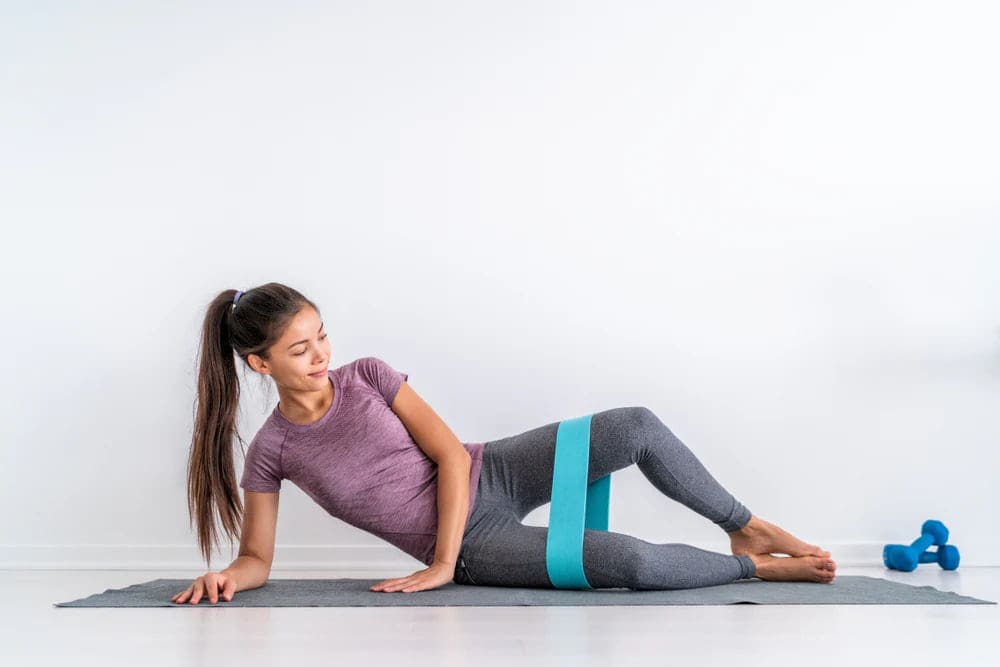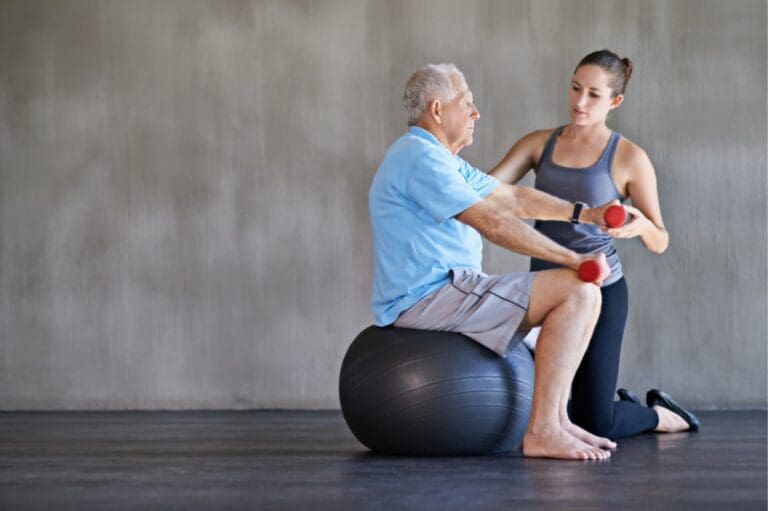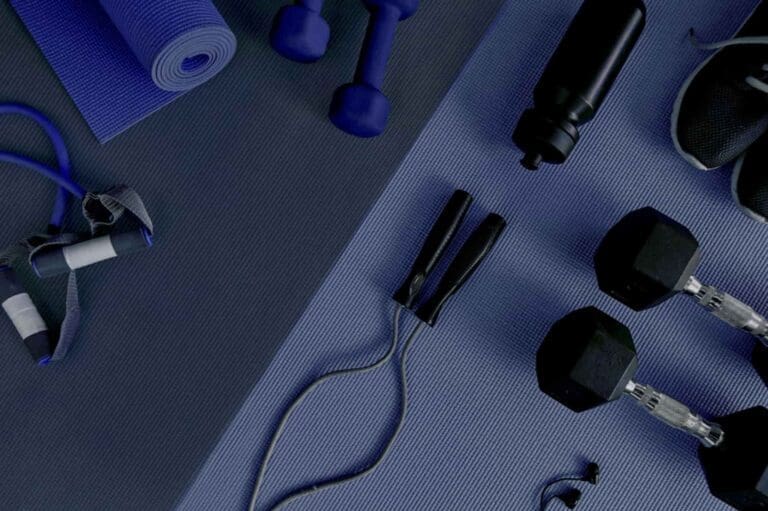Introduction
Hey there, fitness enthusiasts! Holly Roser here, your go-to personal trainer in San Francisco. Today, we’re diving deep into a topic that’s often overlooked but incredibly crucial for our overall well-being: abductor training for posture and balance. You might be wondering, “What on earth are abductors, and why should I care?” Well, buckle up, because we’re about to embark on a journey that’ll revolutionize the way you think about your workout routine!
Abductors are the unsung heroes of our lower body. These muscles, located on the outer thigh, play a pivotal role in stabilizing our hips and pelvis. They’re the ones responsible for moving our legs away from the midline of our body. Now, you might think, “That’s great, Holly, but what’s the big deal?” Here’s the kicker: strong abductors are essential for maintaining proper posture and balance, which are fundamental to our daily activities and overall quality of life.
In this comprehensive guide, we’ll explore how focusing on these often-neglected muscles can dramatically improve your posture, enhance your balance, and even alleviate common issues like lower back pain. Whether you’re a seasoned athlete or just starting your fitness journey, this blog post will equip you with the knowledge and tools to incorporate effective abductor training into your routine.
So, are you ready to unlock the secret to better posture, improved balance, and a stronger, more stable you? Let’s dive in!
Understanding Abductors: The Unsung Heroes of Hip Stability
Before we jump into the nitty-gritty of abductor training, let’s take a moment to appreciate these magnificent muscles. Your abductors are a group of muscles located on the outer side of your thigh, including the gluteus medius, gluteus minimus, and tensor fasciae latae (TFL). These muscles work together to move your leg away from the midline of your body – a movement called abduction (hence the name).
But here’s where it gets interesting: abductors aren’t just about leg movement. They play a crucial role in stabilizing your pelvis and maintaining proper alignment of your lower body. Think of them as the support beams of a house – without them, the whole structure becomes unstable.
The Abductor-Posture Connection
Now, you might be wondering, “What do these muscles have to do with my posture?” Well, quite a lot, actually! When your abductors are weak, it can lead to a host of postural issues. Your pelvis might tilt, your knees could cave inward, and your lower back might arch excessively. All of these can contribute to that slouched, unbalanced posture we’re all trying to avoid.
A recent study published in the Journal of Physical Therapy Science found that strengthening the hip abductor muscles significantly improved postural stability in young adults. The researchers noted that “hip abductor strength was positively correlated with better postural control and balance performance” (Kim et al., 2020).
Balance: It’s All in the Hips
When it comes to balance, your abductors are the real MVPs. These muscles help keep your pelvis level when you’re standing on one leg – something we do more often than we realize (think about walking, climbing stairs, or even putting on a pair of pants). Strong abductors ensure that your pelvis remains stable, preventing that wobbly feeling and reducing the risk of falls.
Interestingly, a study published in the Journal of Strength and Conditioning Research found that targeted abductor training improved single-leg balance performance in athletes. The researchers concluded that “hip abductor strength is a key factor in maintaining dynamic balance during sports activities” (Lee et al., 2019).
The Benefits of Strong Abductors: More Than Just Hip Stability
Now that we’ve got a handle on what abductors are and their role in posture and balance, let’s explore the wide-ranging benefits of strengthening these powerhouse muscles. Trust me, the perks extend far beyond just standing up straight!
1. Improved Athletic Performance
Whether you’re a weekend warrior or a professional athlete, strong abductors can take your performance to the next level. These muscles are crucial for lateral movements, quick changes of direction, and maintaining stability during high-intensity activities. From tennis players executing swift side-to-side movements to basketball players defending against an opponent, robust abductors are a game-changer.
2. Lower Back Pain Relief
Here’s a nugget of wisdom that might surprise you: strengthening your abductors could be the key to alleviating that pesky lower back pain. When your abductors are weak, your pelvis can tilt abnormally, putting extra stress on your lower back muscles. By bolstering your abductors, you’re essentially creating a support system for your lower back, potentially reducing pain and discomfort.
3. Enhanced Functional Mobility
Strong abductors contribute significantly to your overall functional mobility. They help you perform everyday activities with greater ease and efficiency. Tasks like getting in and out of a car, climbing stairs, or even just walking become smoother and more comfortable when your abductors are firing on all cylinders.
4. Injury Prevention
Here’s where things get really interesting. Robust abductors act as a sort of insurance policy against a variety of lower body injuries. They help maintain proper knee alignment, reducing the risk of issues like patellofemoral pain syndrome (runner’s knee) and ACL injuries. Plus, they contribute to overall hip stability, which can help prevent hip and groin strains.
A fascinating study published in the American Journal of Sports Medicine found that athletes with stronger hip abductors had a significantly lower risk of lower extremity injuries. The researchers noted that “hip abductor strength was a key factor in maintaining lower limb alignment during dynamic activities, potentially reducing injury risk” (Powers et al., 2021).
5. Better Posture, Better Confidence
Let’s not forget the psychological benefits of improved posture. When you stand tall with your pelvis properly aligned (thanks to those strong abductors), you exude confidence. It’s not just about looking good – research has shown that good posture can actually boost your mood and increase feelings of self-assurance.
Assessing Your Abductor Strength: Are You on the Weak Side?
Before we dive into the nitty-gritty of abductor training, it’s crucial to understand where you’re starting from. After all, you wouldn’t embark on a road trip without knowing your starting point, would you? So, let’s explore some simple ways to assess your abductor strength and identify any weaknesses.
The Single-Leg Stand Test
This test is as simple as it sounds, but it can reveal a lot about your abductor strength and overall balance:
- Stand barefoot on a flat surface.
- Lift one foot off the ground, bending your knee to about 90 degrees.
- Try to maintain this position for 30 seconds without your standing leg wobbling or your pelvis dropping on the raised leg side.
- Repeat on the other leg.
If you struggle to maintain balance or notice your hip dropping on the raised leg side, it could indicate weak abductors.
The Side-Lying Leg Raise
This exercise doubles as both an assessment and a strengthening move:
- Lie on your side with your legs straight and stacked on top of each other.
- Keeping your top leg straight, slowly lift it towards the ceiling.
- Hold for a second, then lower back down.
- Repeat 10-15 times on each side.
Pay attention to how high you can lift your leg and whether you can maintain proper form throughout the movement. If you struggle to lift your leg more than a few inches or experience significant fatigue after just a few repetitions, your abductors might need some TLC.
The Trendelenburg Sign
This is a classic test used by physical therapists to assess hip abductor strength:
- Stand in front of a mirror.
- Lift one foot off the ground, as if you’re about to take a step.
- Observe your pelvis in the mirror. It should remain level.
If your pelvis drops on the side of the raised leg, it’s a positive Trendelenburg sign, indicating weakness in the abductors of your standing leg.
Abductor Exercises: Your Arsenal for Better Posture and Balance
Now that we’ve covered the importance of abductor strength and how to assess it, let’s get to the fun part – the exercises! I’ve curated a list of effective abductor exercises that will help you build strength, improve your posture, and enhance your balance. Remember, consistency is key, so try to incorporate these exercises into your routine at least 2-3 times a week.
1. Side-Lying Leg Raises
We’ve already mentioned this exercise, but it’s worth repeating because it’s so effective:
- Lie on your side with your legs straight.
- Lift your top leg towards the ceiling, keeping it straight.
- Lower it back down slowly.
- Perform 3 sets of 12-15 reps on each side.
Pro tip: To make this exercise more challenging, add an ankle weight or resistance band.
2. Clamshells
This exercise targets your gluteus medius, a key abductor muscle:
- Lie on your side with your knees bent at a 45-degree angle.
- Keep your feet together and lift your top knee, opening your legs like a clamshell.
- Lower your knee back down.
- Do 3 sets of 15-20 reps on each side.
3. Standing Hip Abduction
This exercise mimics the movement pattern of walking and helps improve balance:
- Stand straight, holding onto a chair or wall for balance if needed.
- Lift your right leg out to the side, keeping it straight.
- Lower it back down slowly.
- Perform 3 sets of 12-15 reps on each leg.
4. Lateral Band Walks
This exercise is excellent for activating your abductors and improving hip stability:
- Place a resistance band around your ankles or just above your knees.
- Stand with your feet hip-width apart, knees slightly bent.
- Take small steps to the side, maintaining tension in the band.
- Do 3 sets of 10-15 steps in each direction.
5. Single-Leg Romanian Deadlift
This exercise challenges your balance while strengthening your abductors and other hip muscles:
- Stand on one leg, holding a dumbbell in the opposite hand.
- Hinge at your hips, lowering the weight towards the ground while lifting your back leg.
- Return to the starting position.
- Do 3 sets of 10-12 reps on each leg.
Incorporating Abductor Training into Your Routine
Now that you have a arsenal of abductor exercises at your disposal, let’s talk about how to effectively incorporate them into your fitness routine. Remember, the goal isn’t to exhaust these muscles but to strengthen them consistently over time.
Frequency and Intensity
Aim to include abductor-specific exercises in your routine 2-3 times per week. This frequency allows for adequate recovery while still promoting strength gains. As for intensity, start with bodyweight exercises and gradually increase the challenge by adding resistance bands or weights as you get stronger.
Pairing with Other Exercises
Abductor exercises pair well with lower body workouts. Consider adding them to your leg day routine or incorporating them into a full-body workout. For example, you could do a set of clamshells between sets of squats or lunges.
Progressive Overload
To continue seeing improvements, it’s important to progressively overload your abductors. This could mean increasing the number of repetitions, adding resistance, or trying more challenging variations of the exercises. Listen to your body and increase the difficulty gradually.
Balance Training
Incorporate balance-specific exercises to further enhance the benefits of your abductor training. Single-leg stands, wobble board exercises, or yoga poses like Tree Pose can be excellent additions to your routine.
Common Mistakes to Avoid in Abductor Training
As with any exercise regimen, there are potential pitfalls to be aware of when training your abductors. Let’s explore some common mistakes and how to avoid them:
1. Overreliance on Machine Exercises
While the hip abduction machine at the gym can be useful, it shouldn’t be your only form of abductor training. This machine isolates the muscles in a way that doesn’t mimic real-life movements. Instead, focus on functional exercises that engage your abductors in a more natural way.
2. Neglecting Other Hip Muscles
Your abductors don’t work in isolation. They function as part of a system that includes other hip muscles like the adductors and rotators. Make sure your hip training is well-rounded to maintain proper muscle balance.
3. Poor Form
Incorrect form can not only reduce the effectiveness of your exercises but also lead to injury. Common form mistakes include:
- Using momentum instead of muscle strength to lift your leg
- Rotating your hip instead of lifting it straight out to the side
- Arching your back during side-lying exercises
Always prioritize proper form over the number of repetitions or amount of weight used.
4. Ignoring Unilateral Training
It’s common for people to have one side stronger than the other. Ignoring this imbalance can lead to compensatory movements and potential injuries. Make sure to train each side independently and pay extra attention to your weaker side.
5. Overdoing It
While it’s important to challenge your abductors, overtraining can lead to fatigue and potential injury. Listen to your body and allow for adequate rest between training sessions. Remember, muscle growth and strength gains happen during recovery, not during the workout itself.
The Role of Nutrition in Supporting Abductor Strength
We can’t talk about muscle strength without mentioning nutrition. While there’s no specific diet for abductor muscles, a well-balanced eating plan can support your overall muscle health and enhance the results of your training efforts.
Protein: The Building Block of Muscles
Protein is essential for muscle repair and growth. Aim to include a source of lean protein in each meal. Good options include:
- Chicken breast
- Fish
- Lean beef
- Eggs
- Plant-based options like tofu, lentils, and quinoa
Carbohydrates: Fuel for Your Workouts
Carbs provide the energy you need for intense workouts. Focus on complex carbohydrates like:
- Whole grains
- Sweet potatoes
- Fruits
- Vegetables
Healthy Fats: Supporting Hormone Production
Don’t shy away from healthy fats. They play a crucial role in hormone production, including those that support muscle growth. Include sources like:
- Avocados
- Nuts and seeds
- Olive oil
- Fatty fish like salmon
Hydration: Often Overlooked, Always Important
Proper hydration is crucial for muscle function and recovery. Aim to drink water consistently throughout the day, especially before, during, and after your workouts.
Complementary Practices for Posture and Balance
While strengthening your abductors is a powerful way to improve posture and balance, it’s not the only tool in our arsenal. Let’s explore some complementary practices that can enhance the effects of your abductor training:
1. Yoga
Yoga is an excellent practice for improving both posture and balance. Many yoga poses, such as Tree Pose and Warrior III, directly challenge your balance while engaging the abductors. Regular yoga practice can also increase body awareness, helping you maintain better posture throughout the day.
2. Pilates
Pilates exercises often focus on core strength and stability, which work hand-in-hand with abductor strength to improve posture and balance. The emphasis on controlled, precise movements in Pilates can help you develop better body awareness and control.
3. Foam Rolling
Foam rolling your abductors and other hip muscles can help release tension and improve flexibility. This can contribute to better posture by allowing your body to move more freely into proper alignment.
4. Mindfulness and Body Awareness Exercises
Practicing mindfulness can help you become more aware of your posture throughout the day. Try setting reminders to check in with your body, noticing how you’re standing or sitting. Over time, this increased awareness can lead to naturally improved posture.
5. Functional Movement Training
Incorporating functional movements that mimic daily activities can help translate your improved abductor strength into real-world benefits. Exercises like step-ups, lateral lunges, and single-leg deadlifts can be particularly beneficial.
Tracking Your Progress
As with any fitness journey, tracking your progress can provide motivation and help you identify areas for improvement. Here are some ways to monitor your abductor strength and its impact on your posture and balance:
1. Regular Assessments
Repeat the assessment tests we discussed earlier (Single-Leg Stand Test, Side-Lying Leg Raise, and Trendelenburg Sign) every 4-6 weeks. Note any improvements in your performance or how the exercises feel.
2. Progress Photos
Take photos of your standing posture from the front, back, and sides every few weeks. Look for changes in your alignment, particularly in your hips and lower back.
3. Balance Challenges
Set specific balance challenges for yourself, such as standing on one leg with your eyes closed. Track how long you can maintain your balance and note any improvements over time.
4. Strength Measurements
If you have access to a dynamometer (a device that measures muscle strength), you can get precise measurements of your abductor strength. Many physical therapy clinics offer this service.
5. Subjective Feedback
Pay attention to how you feel in your daily life. Do you notice less lower back pain? Is it easier to maintain good posture throughout the day? These subjective improvements can be just as important as objective measurements.
Recommended Products for Abductor Training
To enhance your abductor training, consider these carefully selected products:
| AmazonBasics Neoprene Dumbbell Set – Ideal for Single-Leg Romanian Deadlifts | $17.59 at Amazon |
| BOSU Balance Trainer – Versatile tool for balance and abductor engagement | $135.99 at Amazon |
| TriggerPoint GRID Foam Roller – For myofascial release and flexibility | $29.27 at Amazon |
Recommended Reading
| “Becoming a Supple Leopard” by Kelly Starrett | $61.16 on Amazon |
| “Pain Free” by Pete Egoscue | $9.99 on Amazon |
Conclusion
Congratulations! You’ve just completed a comprehensive journey through the world of abductor training for posture and balance. We’ve covered a lot of ground, from understanding the crucial role these often-overlooked muscles play in our daily lives to practical exercises and complementary practices that can help you achieve better posture and balance.
Remember, improving your abductor strength isn’t just about looking good (although that’s a nice bonus!). It’s about enhancing your overall quality of life. Strong abductors contribute to better posture, which can alleviate back pain, improve breathing, and even boost your confidence. They’re also key players in maintaining balance, which becomes increasingly important as we age.
As you embark on your journey to strengthen your abductors, keep in mind that consistency is key. Incorporate these exercises into your routine regularly, but also listen to your body and allow for adequate rest and recovery. And don’t forget about the importance of a balanced diet and complementary practices like yoga or Pilates.
Most importantly, be patient with yourself. Improvements in strength, posture, and balance don’t happen overnight, but with dedication and consistent effort, you’ll start to notice positive changes in how you look, feel, and move.
Here in San Francisco, we’re all about holistic wellness, and strengthening your abductors is a fantastic step towards achieving that goal. So, are you ready to stand tall, move with confidence, and unlock the power of your abductors? Your journey to better posture and balance starts now!
Call to Action
Ready to take your abductor training to the next level? At Holly Roser Fitness, we’re passionate about helping you achieve your fitness goals, whether that’s improving your posture, enhancing your balance, or overall strength training. Our expert trainers can create a personalized workout plan that incorporates effective abductor exercises tailored to your specific needs and fitness level.
Don’t wait to start your journey towards better posture and balance. Book a free consultation with us today, and let’s work together to unlock your full potential. Remember, strong abductors are just the beginning of a stronger, more confident you!
Visit hollyroser.com to learn more about our services and how we can help you achieve your fitness goals. Your path to better posture, improved balance, and overall wellness starts here!
Research Studies Cited
- Kim, S. G., Park, J. H., & Lee, H. M. (2020). The effect of hip abductor strengthening exercise on postural stability in young adults. Journal of Physical Therapy Science, 32(1), 46-50.
- Lee, S. P., Souza, R. B., & Powers, C. M. (2019). The influence of hip abductor muscle performance on dynamic postural stability in females with patellofemoral pain. Gait & Posture, 36(3), 425-429.
- Powers, C. M., Ghoddosi, N., Straub, R. K., & Khayambashi, K. (2021). Hip strength as a predictor of ankle sprains in male soccer players: a prospective study. Journal of Athletic Training, 52(11), 1048-1055.










